|
|
Post by Don Ricardo on Apr 12, 2009 22:22:56 GMT 10
BRINDLE (& COOPER) CARAVANSManufactured by Albert Brindle operating as Brindle & Cooper and Brindle Caravans Pty Ltd 326/8 Liverpool Road, Ashfield, NSW
On 12 April 2009, Franklin1 wrote: I've just found a 1977 article in the newspaper archives that says:
"The Australian caravan industry commenced in the early 1930s and the earliest manufacturers included Jennison, Carapark, and Brindle in NSW, and Don caravans in Victoria."
Brindle?? Never heard of 'em...  
Over to you, cobber, for an update on the Brindle name... 
cheers,
Al.
|
|
|
|
Post by cobber on Feb 13, 2010 15:26:44 GMT 10
OK Al, Took a while but I've been working on it non stop. From the Sydney Morning Herald November, 1934. More like a camper trailer. This is page one.  And this page two 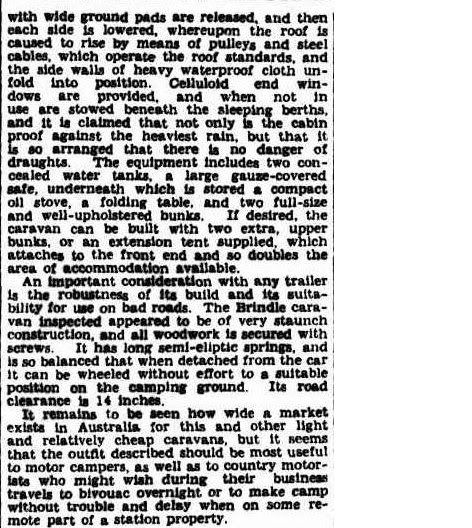 But then in December 1939  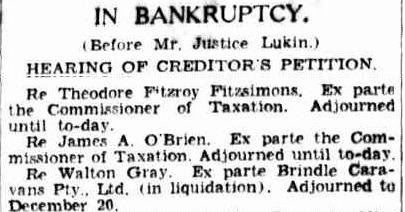 Cobber. |
|
|
|
Post by Don Ricardo on Feb 15, 2010 22:00:33 GMT 10
Hi Cobber, Well done on tracking down some info on the Brindle at last. Nice piece of detective work! Now I don't want you to think that I'm trying to steal your glory - or suggest that your work left something to be desired (far from it, I assure you) - but I noticed that the SMH article mentioned two photos, and your post only showed one. So, I went back to source and found this: 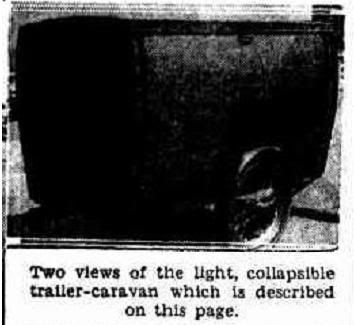 It is a very blurry photo which doesn't tell you much at all, but it did remind me very much of something which can be seen here. "A very strong resemblance, no?", as the continentals might say. Just wonder if there is some link? Also, I noted the article stated that the Brindle was soon to be produced in England. I wonder if that ever happened? A bit like taking coals to Newcastle I would have thought, but who knows. Perhaps you could enquire of your UK contacts whether they have heard of a Brindle camper trailer/van being produced or sold there? Don Ricardo |
|
|
|
Post by cobber on Feb 16, 2010 6:26:52 GMT 10
By Jove Sherlock....I think you are right...... on all counts. My work was sloppy and you have stolen my glory...    But most importantly you are right in linking the “Brindle” with the “Reo”. Judging by the photos and the description of the “Brindle”.... “ whereupon the roof is caused to rise by means of pulleys and steel cables”.... if these two trailers are not the one and the same I'll eat my hat. My interpretation of what the article is saying, “... and the unit is also being produced in England ” indicates the present tense to me. I have previously asked my friend in the UK if he recognised the “Reo” and he responded in the negative, but we will try again with the additional clue. I have to admit I didn't read the Brindle article when I posted it.... sloppy !  ...sloppy !  ....sloppy!!     Cobber. |
|
|
|
Post by Don Ricardo on Mar 19, 2011 23:15:59 GMT 10
It seems that Mr Albert Brindle was a patriotic chap, although his gift didn't save his company from bankruptcy later in the same year, as shown in Reply #1. Article from The Sydney Morning Herald, Friday 3 March 1939, page 12: 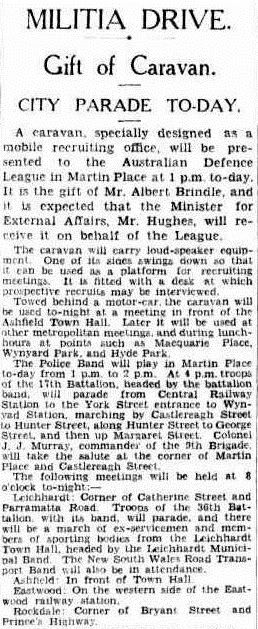 (Source: National Library of Australia nla.gov.au/nla.news-article17593232 ) It's hard to believe that one of the little Brindle camper trailers pictured in Reply #1 would have been big enough to use as a recruiting office, so this may suggest that Mr Brindle launched out into full size caravans between 1934 when he announced his camper trailer, and 1939 when he made his gift. Whether or not this is the case will have to wait on further info. Don Ricardo |
|
|
|
Post by cobber on May 4, 2013 9:25:25 GMT 10
In an effort to compensate for my sloppy research elsewhere in this thread I submit the following patent application dated 4th. December 1934. The way I see it Albert Brindle is describing a system of ropes and pulleys to raise the roof and lower the sides on a camper trailer that looks very similar to the English "Rice" folding caravan that had a very similar system of ropes and pulleys to perform the same function  (Patent applied for in 1930/31) (Patent applied for in 1930/31).. In fact the original "Rice folding" caravan was built along the same lines in 1928  So.....I think Albert Brindle might have been registering the design (with slight modifications) in Australia in order to gain copyright of it here and then went on to build the "Reo" a couple of years later. More photos of the "Reo" and the English "Rice" caravans can be seen in the Reo thread HERE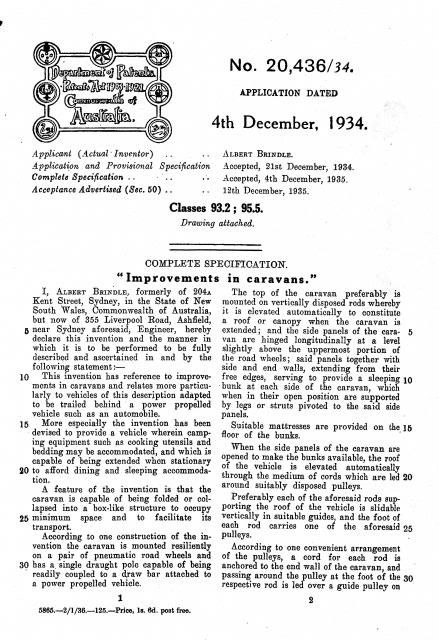 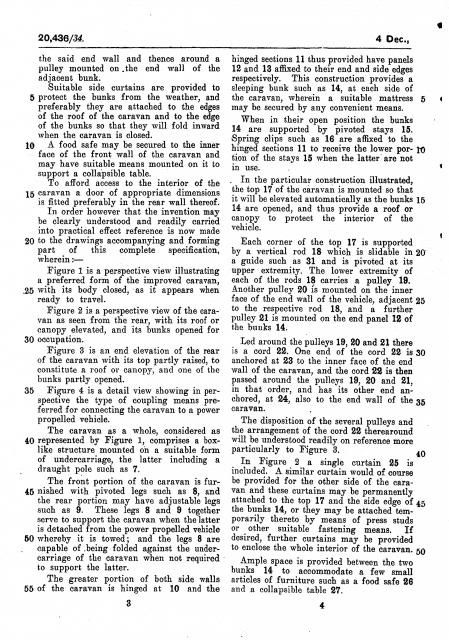   The English "Rice" folding caravan mosaics 1930 can be seen hereCobber. |
|
|
|
Post by Don Ricardo on May 5, 2013 21:59:49 GMT 10
G'day Cobber, I read your post about Reo/Brindle caravans yesterday with interest. Then searching through the forum for something entirely different (as often happens) I came across a post by Malrv1 in 2010 here. His post included this photo: 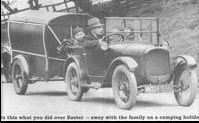 Malrv1 advised that it was: "...a photo that appeared in the South Australian Austin 7 Club magazine. Not sure of the year but the Austin is a mid 1920s model." Looking at the photo, it struck me that the caravan is a probably a Reo/Brindle. What do you think? Malrv1 posted the photo as an attachment, and unfortunately he is no longer a forum member so we can't click on the attachment to make it larger. Don Ricardo |
|
|
|
Post by cobber on May 6, 2013 7:19:00 GMT 10
G'day Don D, I got an enlarged photo no worries that clearly shows the number plate, which I think ? , indicates the photo was taken in "the mother country", somebody who knows about number plates can straighten me out there please   As mentioned above the Rice caravan was first made in 1928, and continued until the start of WWII, and from photos I have seen there were a few modification to the way the ropes and pulleys worked, and also some subtle changes to the shape of the van. This caravan certainly looks more like the English "Rice" version than our Reo/Brindle I think  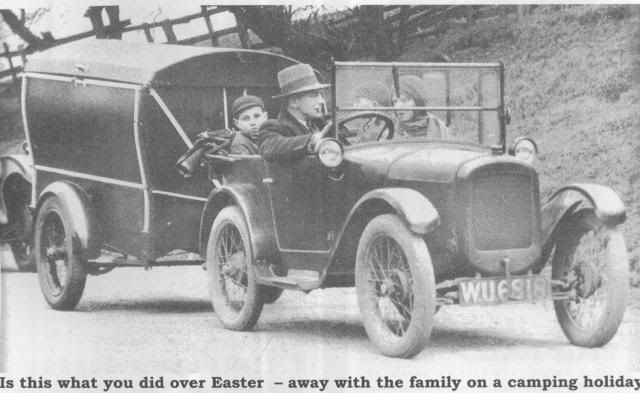 Rice  Reo/Brindle 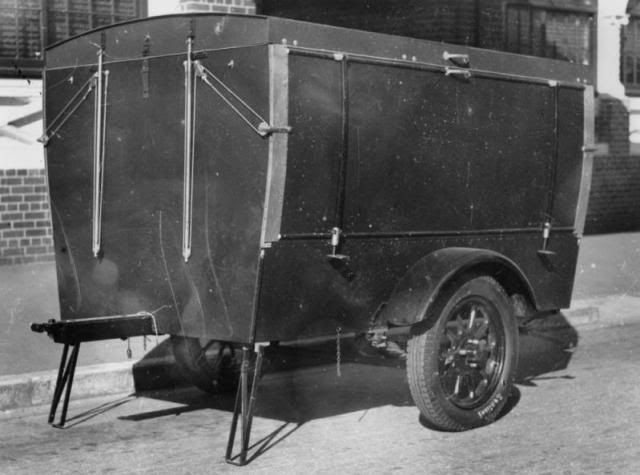 Cobber. |
|
|
|
Post by shesgotthelook on May 6, 2013 9:29:38 GMT 10
I have a teriffic English caravan magazine from 1939. In it is a story/blog titled 'Round Europe By Rice 27000 miles on the trail of freedom & adventure' 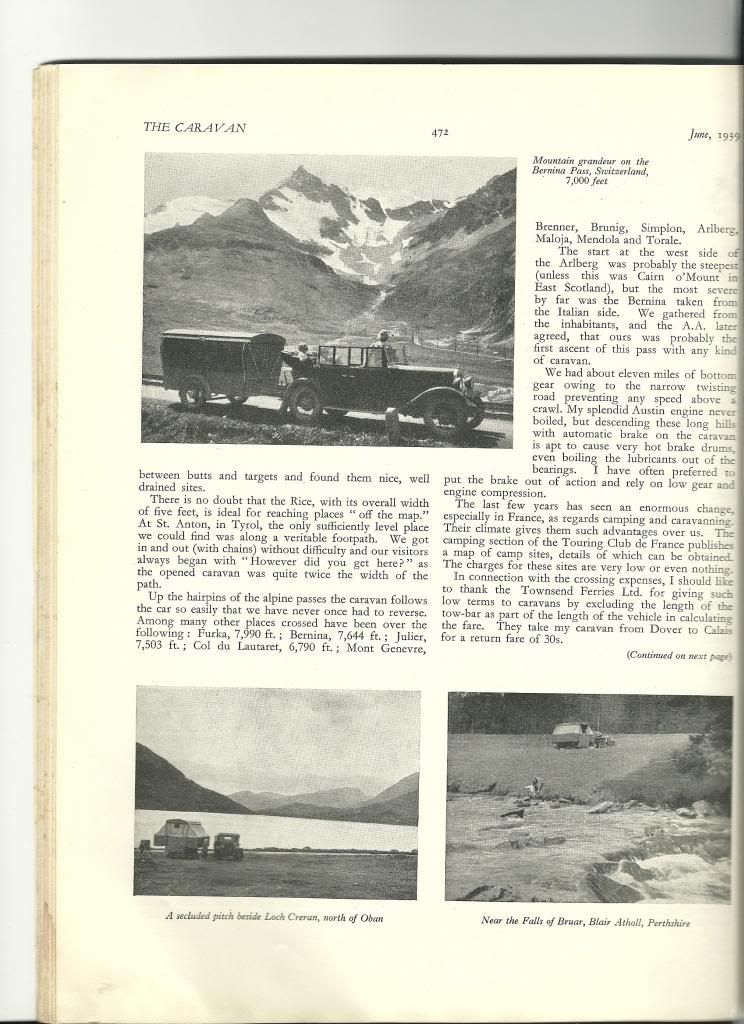 |
|
|
|
Post by cobber on May 6, 2013 10:45:46 GMT 10
G'day shesgotthelook, Thanks for posting that page, a few good photos showing how determined the British were to enjoy themselves in the pioneering days of caravanning  Some of the manufacturers did do some incredible things to convince people their caravans could go anywhere, and it would appear that the Rice was something the Austin 7 could handle  As it could be that Mr. Brindle might have possibly got his inspiration for the Brindle/Reo caravan from the Rice caravan... maybe   it's probably OK to show a few more photos of the Rice  Here are a couple of more photos of "Rice" caravans stolen from this Austin 7 UK web site (an interesting read I reckon  )  The Rice came in three sizes apparently and it is assumed this photo of the interior would be of the larger one. 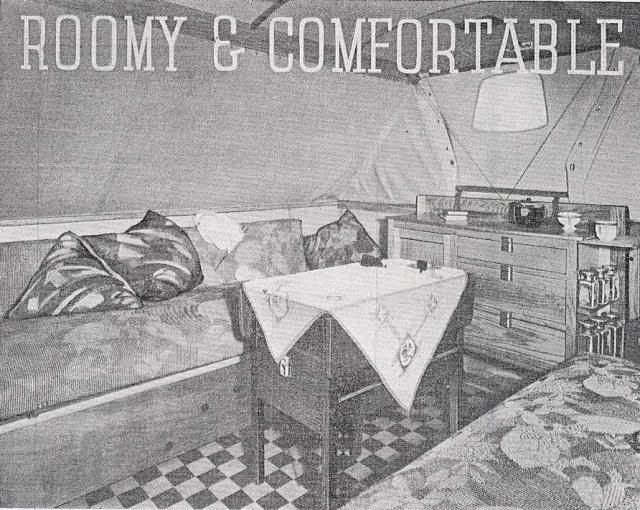 What more do you need ? I found a video clip of what I think is a rice caravan m.youtube.com/watch?v=JbPx-FPMEX0Cobber. |
|
|
|
Post by shesgotthelook on May 6, 2013 11:16:01 GMT 10
Hi Cobber, I was a bit nervous posting pics of an English rig but it does give you some background. Wouldn't it be fab to find an old Brindle Reo & fix it up? Get Austin 125 onto it I say ;D
|
|
|
|
Post by cobber on May 6, 2013 11:56:46 GMT 10
Gee SGTL, don't be nervious  it's all in the pursuit of knowledge..... here is another Rice photo showing for the first time the rear of the van   Cobber. |
|
|
|
Post by smiles on May 7, 2013 13:26:19 GMT 10
Hi all I've been following this thread with great interest since we bought our latest little folding van on the Toads n Roaches tour. We have yet to pick it up but it feels like its a more advanced version of these little beauties. You can see how the Brindle & Rice vans took a covered wagon & adapted it till it became a van pulled by a light car but still with all the features of a canvas covered wagon. We measured our new can & it's only 5'9" wide! I noticed the rice or the brindle was only 5 ft wide! Sleep in the foetal position while on hols perhaps, just to make you appreciate home more! Just to complicate things more... check this out! m.gumtree.com.au/v?adId=1018245383Once again, thanks to all you avid researchers. This is what makes this site fantastic...working out the evolution of vans in the last 90-100 years. smiles |
|
|
|
Post by cobber on May 7, 2013 14:48:02 GMT 10
G'day smiles, Pleased you appreciate this thread  look forward to seeing photos of your toads and roaches pick up ;D As the beds were length wise along the sides of the vans they would have been fairly comfortable I think, especially the two longer ones. I should have mentioned the three sizes the Rice van was available in... There was a 2 berth standard...a 2 berth long standard.... and a 3 berth major. Respectively they were.... Body length 6 ft... 8 ft.... 8 ft. The widths closed ( excluding mud guards) were 3ft 8 in....3ft 8 in... 4 ft 7 in. The extended widths were 7 ft 1 in...7 ft 1 in... 8 ft 4 in. Hight closed were 5ft 3 1/2in.... 5ft 3 1/2in...5ft 8 1/2 in Head room extended were 5 ft 8 in....5ft 8 in....6 ft. Weights were 4 1/2cwt....5 1/2 cwt....7 1/4 cwt They were built with a hardwood frame, panelled with treated plywood that was finished with cellulose fabric.... much the same as quoted in the article that started this thread for the Brindle caravan  The information above comes from the book "British Caravans volume 1" By Roger Ellesmere, a plurry good book for anybody interested in British caravan makes founded before WWll..... and the influence they had on how some Australian caravans developed. Cobber. |
|
|
|
Post by Don Ricardo on Jul 8, 2015 11:52:27 GMT 10
Hi all, For a number of years, on and off, we have discussed Brindle caravans,in the light of an article quoted by Fanklin1 at the top of this thread stating that Brindle was one of the earliest caravan manufacturers in NSW. Cobber has posted the results of his investigation into Brindle on this thread, but all that we have come up with thus far has been information about a folding caravan (what we might now call a folding camper trailer) which was designed and manufactured by Brindle, and seems also to have been built and sold as a Rice caravan in the UK. And yet there is the tantalising report from 1939 (posted above) that Brindle had built a caravan to be used as a mobile recruiting office by the Australian Defence League. (It should be noted that the Australian Defence League was established by the Commonwealth Government in 1938 to assist in recruiting personnel for the various armed forces, and is totally unrelated to the Australian Defence League of today which has an entirely different purpose.) In any case it was agreed in our discussions that it seemed unlikely that a folding caravan would be suitable for use as a mobile recruiting office, raising the possibility that Brindle also built full size caravans... It seems that our supposition back in 2011 was on the money. Following are some photos of a Brindle caravan from the State Library of New South Wales archives: 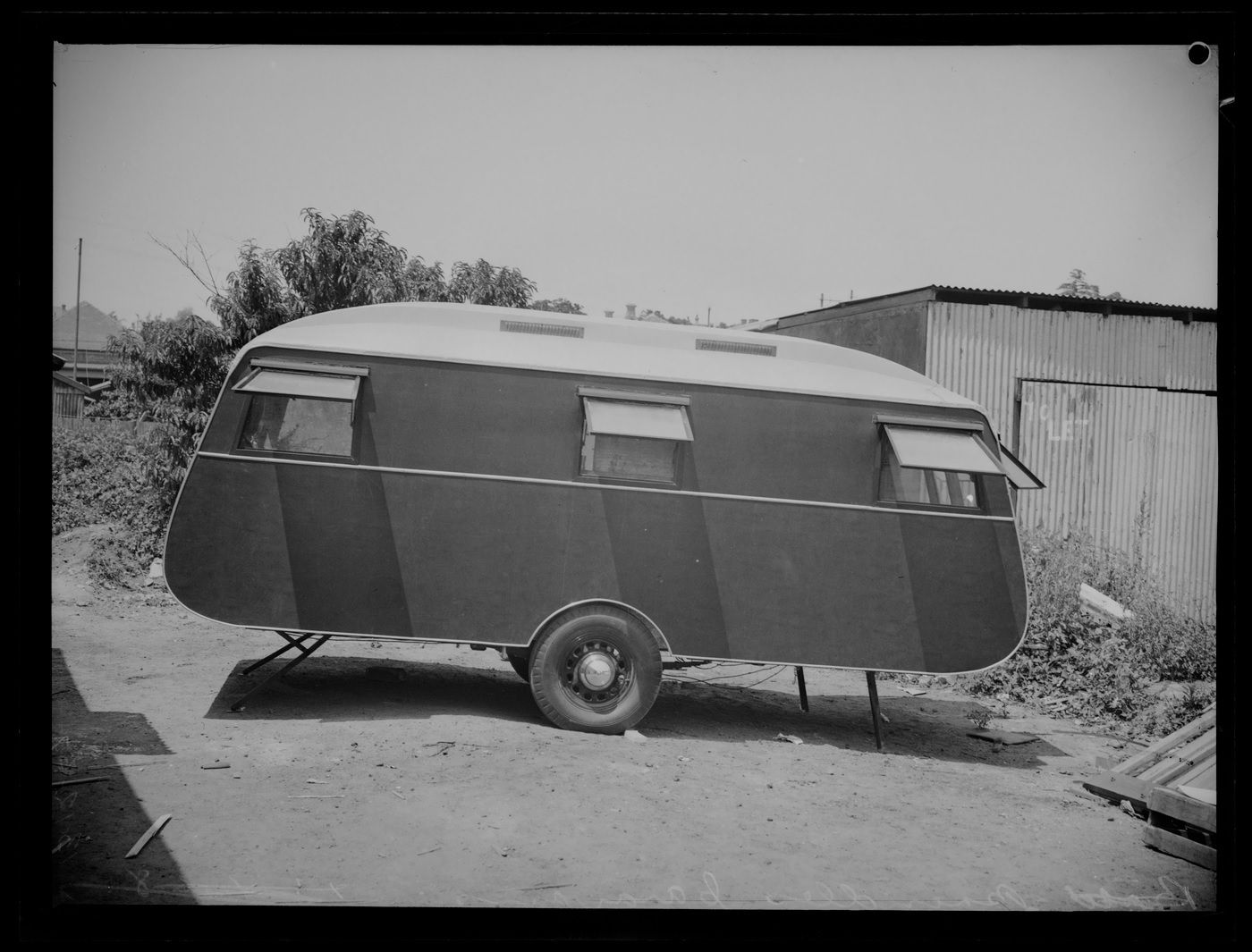 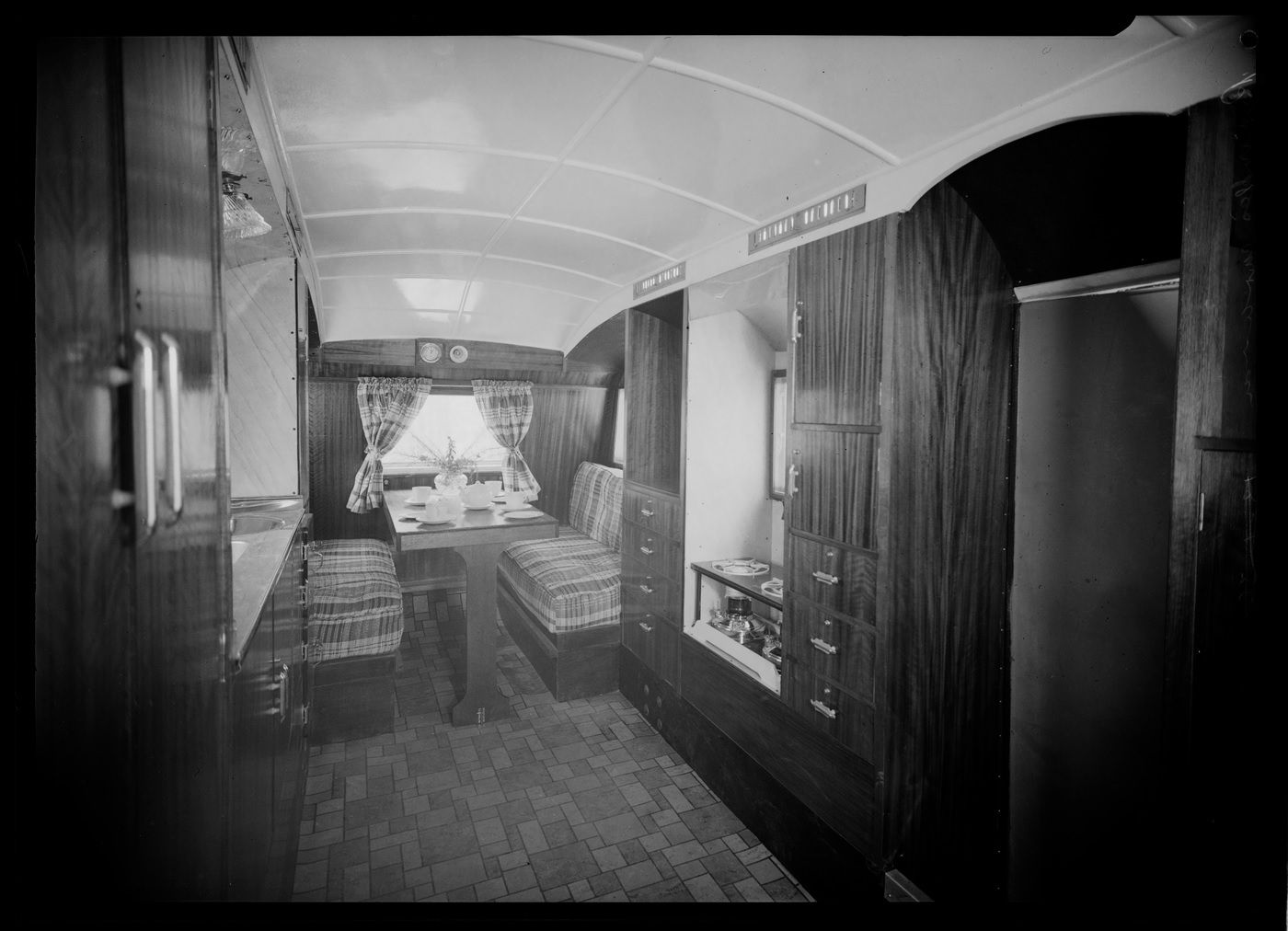 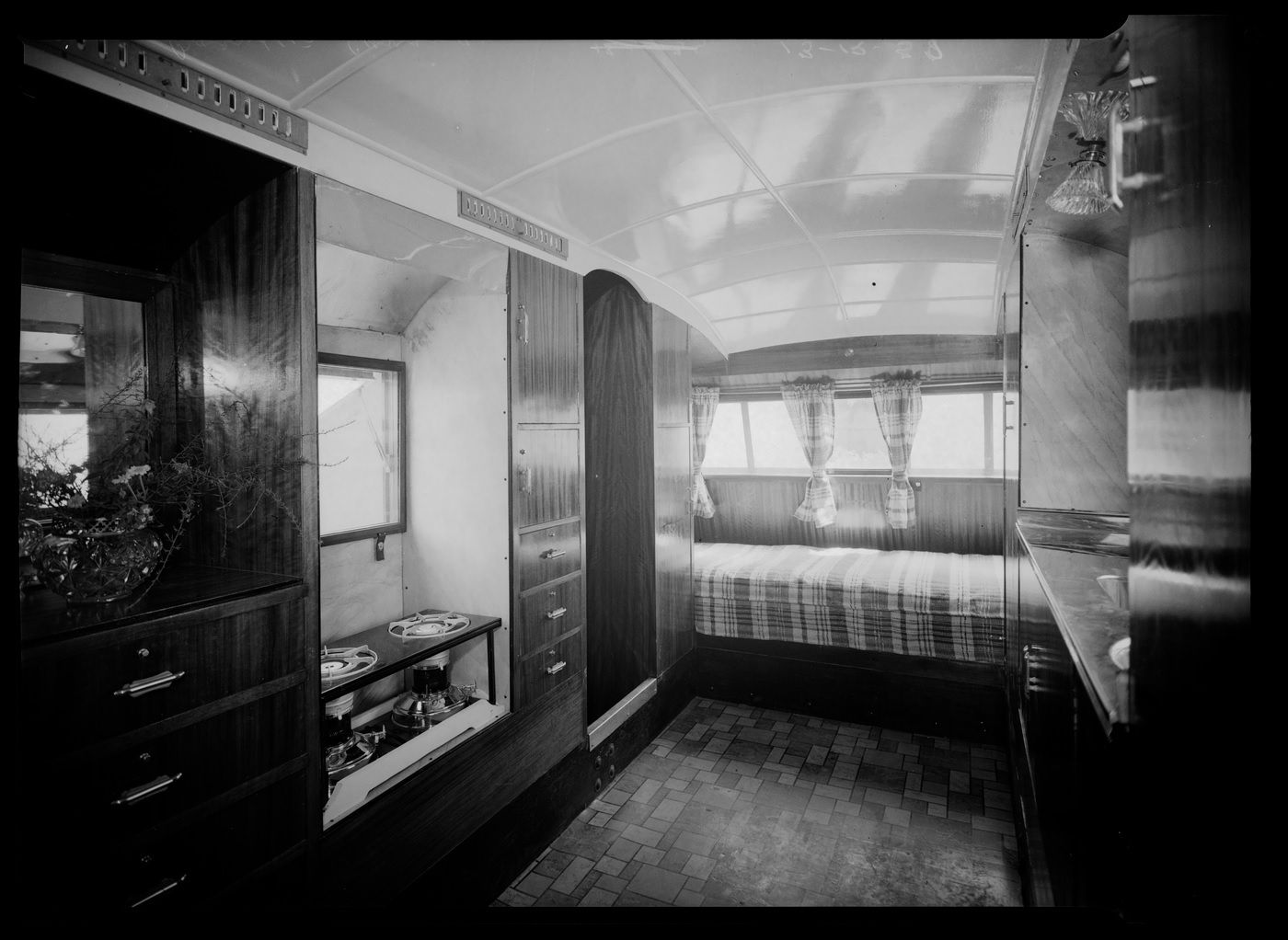 (Source: Mitchell Library, State Library of New South Wales and Courtesy ACP Magazines Ltd acms.sl.nsw.gov.au/item/itemDetailPaged.aspx?itemID=1114919# ) The photos show the Brindle to be fitted out in a very sumptuous manner with some pretty high quality fittings. Even though polished wood was the usual thing in 1930's caravans, the interior of this van seems to be a cut above almost anything else. Note also the unusual tow coupling, which can just be made out in the photo - no A-frame apparently, just a single pole, and quite short at that. It's quite exciting to find some evidence of Brindle's caravan building activities. The photos just show what's there to be found if we keep digging! Don Ricardo |
|
|
|
Post by cobber on Jul 8, 2015 13:47:21 GMT 10
G'day Don R, Well, that is quite a step up from the little old folding trailer that Mr. Brindle started out with isn't it  and it's something Rice caravans in the UK never managed to achieve. I would not dare to belittle his achievement by suggesting this 1937 van could be based on another English design but ...... lantern roof  , sumptuous interior  , worth looking into I reckon  Who would trash a van of this quality ? it must be hiding out there somewhere, let's find it  Cobber. |
|
|
|
Post by Don Ricardo on Jul 8, 2015 16:34:03 GMT 10
Hi Cobber,
The Brindle van is very English looking isn't it, but then a number of the vans built in Australia in the 30's seem to have followed the English style.
Given the apparent connection between the Brindle and the Rice folding caravans, perhaps Mr Brindle had some links with the English caravan scene which may then have influenced the design of his full-size caravans?
Do you notice the stove and what appear to be double sinks/wash basins?
Don Ricardo
|
|
|
|
Post by griffin on Jul 8, 2015 16:40:37 GMT 10
Hi Don That is certainly a classy van, nice to see the State Library is continually adding items to their site to be found and enjoyed. Mr Brindle seems to have gone ahead in leaps and bounds from his little collapsible. I found pictures of his recruiting van on Trove a while back, it was newsworthy enough at the time to make several papers around the country but the attached photo is the best quality one. 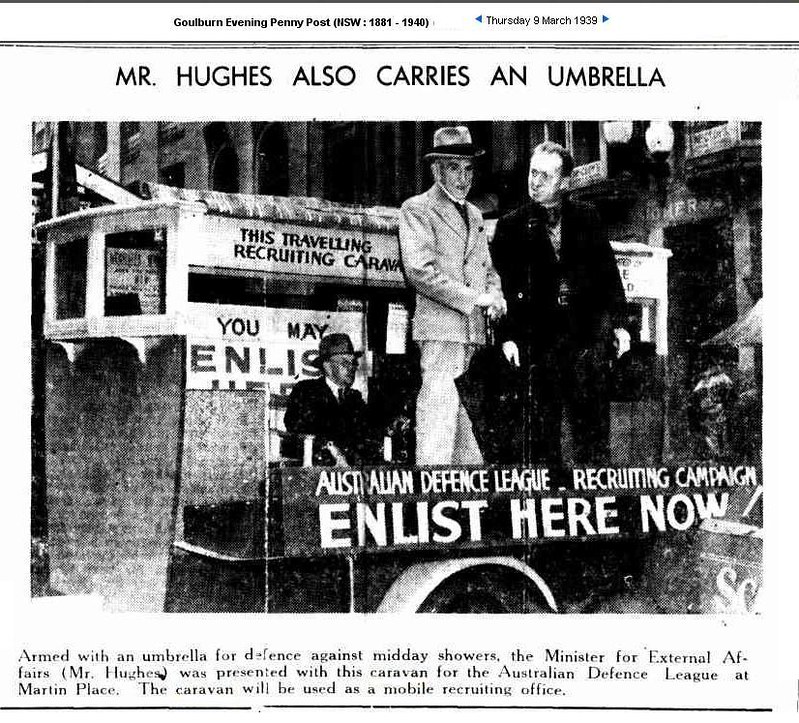 Brindle 4 - Goulburn Evening Penny Post 9-3-1939 Brindle 4 - Goulburn Evening Penny Post 9-3-1939 by viva gt, on Flickr It appears to be fairly box like van with a bay style window at the front, maybe it's the rear, and there is a canvas awning which seems to be folded back over the roof of the van. Some information about the van with it's fold down side and the fact that it was donated by Mr. Brindle (I wonder if that is him with Hughes in the photo?) was published in the Sydney Morning Herald on 3 March, 1939, previously posted by Don Ricardo, and in all it seems it was a big occasion. Hopefully it will all become clear in time. George
ADDENDUM - August 2022: The following little item published in the Sydney Morning Herald on Saturday, 4 March 1939 (page 12) records that Billy Hughes, Minister for External Affairs and former Prime Minister, was introduced to Albert Brindle at the handover of the Brindle recruiting caravan. His reaction to the van was that: "It is the most ingenious device for recruiting that I have ever seen." No doubt Albert Brindle was well pleased. 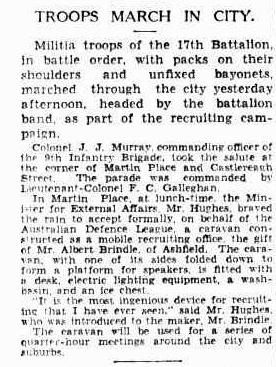 Don Ricardo
|
|
|
|
Post by Don Ricardo on Jul 8, 2015 19:45:52 GMT 10
Hi Griffin,
Thanks for posting that article. It does raise some questions though, doesn't it? The recruiting caravan looks a whole lot less sophisticated and stylish that the van I posted photos of, doesn't it?
Pity we can't sit Mr Brindle down to ask him a few questions about what he got up to back in the day...
Don Ricardo
|
|
|
|
Post by Don Ricardo on Oct 24, 2020 13:43:13 GMT 10
Drawing of a Brindle & Cooper folding caravan used to illustrate an article on caravanning published in the Sydney Daily Telegraph on Friday, 2 December 1936 (page 15):_Fri_4Dec1936_p15_news_article246969556.jpg?width=1920&height=1080&fit=bounds) (Source: National Library of Australia nla.gov.au/nla.news-article246969556 ) The full article can be found here. Note that in this case the folding caravan is identified as 'Brindle & Cooper' rather than just 'Brindle'. Don Ricardo
|
|
|
|
Post by Don Ricardo on Aug 19, 2022 15:31:35 GMT 10
Hi all, It turns out that Brindle (& Cooper) caravans had an interesting history with a few twists and turns in its eight year history between 1934 and 1942. Like quite a few caravan manufacturers in the 30's, the development of their caravans was quite rapid, only to falter in the War years. Some of the information below, which has been compiled in collaboration with Andrew Woodmansey (Woody99), overlaps with what is posted higher up this thread, and with what we already know, but it also answers a few questions we've had about Brindle. Cobber has already posted an article from the Sydney Morning Herald in November 1934 describing the Brindle 'collapsible caravan' here, however the following article published in Smith's Weekly on Saturday, 12 January 1935 (page 16) provides a more succinct description of how the vehicle worked ('Two handles on the top of the sides are pulled and the sides open...') and provides some dimensions - 6ft 2in high and 6ft 6in long when open: _Saturday_12Jan1935_p16_article234612920.png?width=1920&height=1080&fit=bounds) Reference provided by Andrew Woodmansey) Further information about the van is provided in an article appearing in the Goulburn Evening Penny Post on Thursday, 15 October 1936 (page 7):
Reference provided by Andrew Woodmansey) This article reveals that the Brindle caravan: - Was designed by Mr A Brindle but was exhibited in Goulburn by Mr Pope Cooper of Ashfield, and formerly of Goulburn. Ah-hah so that's where 'Cooper' comes from - more on that later.
- Was 6ft 5in high and 3ft 9in wide when closed, and 6ft high inside and 8 ft 6in wide when open.
- Came in three models - standard, intermediate and de luxe, with the latter being four berth.
- Was patented in 1934 but was being marketed more recently.
The last point is interesting because Cobber has posted the patent higher up this thread here. The patent shows that the application was accepted by the Patent Office on 21 December 1934, complete specifications provided on 4 December 1935 and acceptance of the patent advertised on 12 December 1935. That means that the article about the Brindle collapsible caravan from November 1934, posted by Cobber, actually pre-dated acceptance of the patent application by the Patent Office. The following extracts from an article about the 1937 Lithgow Show, printed in the Lithgow Mercury on Monday, 22 February 1937 (page 4), tells us that Messrs Brindle and Cooper had their 'collapsible camping caravan on display at the show:  Highlight added)
We have previously suspected that the collapsible caravans sold by Reo Motors Ltd in Brisbane were built by Brindle, and this is confirmed by the following two items which appeared in the Brisbane Telegraph on Tuesday, 17 August 1937 (page 25). The first item indicates that the van is 'the patented Brindle's caravan' which was 'Built in the South', which presumably was a Queenslander's way of referring to New South Wales! Highlight added) The second item from the Telegraph informs us that three Brindle models were all 6ft high inside when open, but differed in width and length - the standard being 8ft 6in wide and 6ft 6 in long, the intermediate being 9 ft wide and 7ft 6in long, and the de luxe being 10ft 6in wide and 8ft 3in long. Given the difference in widths, I am guessing that must have meant that they also varied in height when closed? The extra width had to go somewhere when packed up. We have to be thankful for Reo Motors because they have provided us with the best photos of the Brindle collapsible caravans, including the photos in this Reo advert published in the Brisbane Truth newspaper on Sunday, 19 September 1937 (page 13). The advert confirms that Reo Motors was the Brisbane agent for the Brindle and provides us with a beautifully clear photo of one of the caravans opened up as well as an internal shot of the de luxe model with the four berths:
At some point in the late 30's, Brindle began to produce full size caravans. There is one example of a beautiful looking caravan in photos from the State Library of NSW shown higher up this thread here, but here are a couple of other examples. First, a caravan shown in a Brindle advert printed in the Sydney Daily Telegraph on Friday, 25 March 1938 (page 17) Reference provided by Andrew Woodmansey) This caravan doesn't have the lantern roof of the van higher up the thread, but does have leadlight windows. The next example of a full size Brindle caravan shows a more modern van with what appears to be a concave front, but also a lantern roof. This advert appeared in the Sydney Daily Telegraph on Wednesday, 18 October 1939 (page 14):
Reference provided by Andrew Woodmansey) While these various vans were being offered to the public, it seems there was also a fair bit going on behind the scenes which suggests that the Brindle business may have been frequently under pressure. This notice published in the Government Gazette of the State of New South Wales (No 66, page 1946) on Friday, 14 May 1937 records the dissolution of the partnership between Albert Brindle and what I am assuming was the Cooper family (Pope Cooper - remember him? - Myrtle Cooper, Hassal Cooper and Lurline Cooper) with all the debts of the Brindle and Cooper business being taken over by Albert Brindle: _p1946_article224751012.png?width=1920&height=1080&fit=bounds) (Source: National Library of Australia nla.gov.au/nla.news-article224751012 ) April 1938 saw a notice being published in the Government Gazette of the State of New South Wales (No 63, page 1634) regarding the proposed winding-up of Brindle Caravans Pty Ltd because it could not meet its liabilities. Note the name of the company Chairman - Walton Gray: Cobber has already posted the following notice from December 1939 here, which indicates that Brindle Caravans Pty Ltd was in liquidation and refers again to Walton Gray: (Source: Cobber) Then on 14 March 1940 we find the following notice published in the Commonwealth of Australia Gazette (No 49, page 622) which refers again to Walton Gray and describes him as 'dental surgeon...also trading as Brindle Caravans' and also refers to an 'arrangement' between him and his creditors who were to receive a 'final dividend': My guess from this string of notices between April 1938 and March 1940, is that after the dissolution of the partnership with the Coopers, Brindle set up a company assisted by the dentist Walton Gray who invested in the company and became its chairman. Apparently the business did not do well financially and went into liquidation with Walton Gray responsible for winding up the company and settling with creditors. The wind-up of the company was completed in February 1942 as recorded in this notice published in the Government Gazette of the State of New South Wales (No 1, page 47) on Friday, 2 January 1942:
As noted above, a number of pre-War caravan manufacturers were bankrupted or closed their businesses in the early 40's, but in the case of Brindle it appears that his business difficulties were already appearing from 1937, even while he was moving from collapsible caravans to full size caravans, and donating caravans for recruiting soldiers (see story here). Perhaps Brindle's forte was as a caravan builder than as a businessman? The above information has told us a bit more about the history of Brindle caravans and resolved the question of whether the collapsible caravans sold by Reo Motors in Brisbane were built by Brindle (they were). However, there is one mystery remaining and that is in relation to the comment in the 1934 Sydney Morning Herald (SMH) article posted by Cobber here that "The Brindle caravan reviewed here is named after its inventor, who is manufacturing the outfit in Sydney, and the unit is also being being produced in England." Is the Brindle the same as the English Rice caravan which is shown in various posts higher up this thread? According to Roger Ellesmere in this book British Caravans (Volume 1: Makes founded before World War II (pages 123-4), the Rice caravan was invented by J Cecil Rice in Yorkshire, and manufacture began in 1928. Early versions of the Rice van look a little different from the Brindle, but the Rice van being produced in 1933 looks remarkably similar in its collapsed state to the Brindle. And like the Brindle, the Rice van had three models, the largest of which was a 4-berth. In addition, if you watch the Youtube video posted by Cobber here and then read the Brindle patent, it seems as if the mechanism for opening up the caravan in both cases was the same. However, looking further, when opened up, the Brindle van shown in the Reo Motors advert in this post ends up with a different shape to the canvas sides on the Rice van, as shown in the photo with the bathing beauty posted by Cobber here, and the dimensions of the three models of the two types of van are different. I am therefore led to the conclusion that while Brindle may possibly have based his van (very closely!) on the Rice, he made sufficient changes to the concept to be able to obtain a patent for his version. So the comment in the SMH that '...the unit is also being produced in England' may possibly be construed as meaning that 'a very similar unit is being produced in England by someone else', not that Brindle's version itself was being produced in England. Given the fact that Brindle's business seems not to have been very successful within the Australian context, it seems unlikely that he had the resources or perhaps even skills to arrange production of his collapsible caravan half a world away. I will be interested in Cobber's perspective on the above conclusion, and on thoughts from anyone else as well. Thanks to Andrew Woodmansey for assisting to compile the above newspaper items. Don Ricardo
|
|
|
|
Post by Don Ricardo on Aug 21, 2022 23:27:52 GMT 10
Hi all, Funny what you come across when you're not looking for it... I was just posting on the Down History Lane '1940's Caravans' thread and noticed the following photo with caption posted by Cobber here in April 2014: "The only one with a date on it “Mc Evoys Caravan @ Tuncurry Park Jan 1943”..."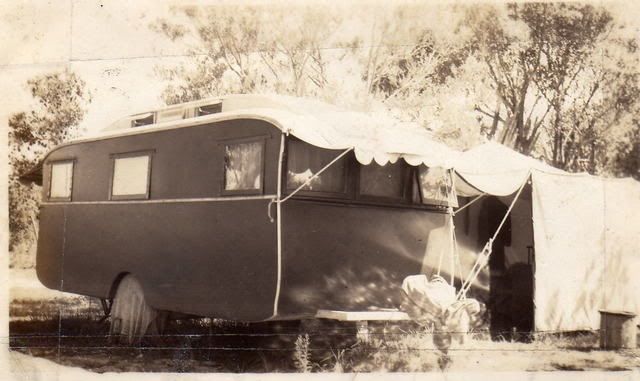 Looks to be identical to the Brindle caravan posted higher up this thread, and seen in this photo:  Reference to the internal photos higher up confirms that the Brindle van had three panel windows at the rear, and most likely at the front. Don Ricardo |
|
|
|
Post by Don Ricardo on Nov 29, 2022 13:36:30 GMT 10
Hi all, In December 2019, I posted the following photo on the 'Down History Lane' Don Caravans thread here. I had found the photo on a Facebook post:  The photo was taken at Munna Point, Noosa, Queensland in 1939, and the reason for posting it on the Don thread was that the first caravan in the convoy belonged to Dick Robinson, father of Don Robinson who designed and built Don caravans. However, the photo is also of interest because of the other caravans in the photo. For example the third van in the lineup is a Windsor caravan. But the second caravan has had me stumped partly because of the unusual profile of the roof. It has a lantern roof, which is not so unusual for the 30's, but note the raised section from the 'lantern' to the doorway. It also appears to have a vent at the front of the 'lantern' section above the front windows.
The same photo was posted yesterday by Kenny here and looking at it, it suddenly struck me that the second caravan is very likely to be a Brindle. As evidence I am posting two photos of Brindle caravans from higher up this thread (see those posts for the sources of the photos): Exhibit A Note that the 'Exhibit A' Brindle caravan has the following features in common with the second caravan in the Munna Point convoy: - Lantern roof (no sign of the raised section over the door, but be patient);
- Three side windows;
- Multi-paned, full width front windows, which is a bit unusual for the 30's);
- Painted a dark colour but with a contrasting coloured waist moulding;
- Light coloured corner strip right around the sides of the van; and
- Quite high rounded external wheel arch.
If you look at the internal photo you'll also note that above the entrance way on the right hand side of the photo, there seems to be a raised section above the entrance, perhaps to give more headroom in the doorway. Exhibit B Now looking at this photo of a Brindle van published in 1938, note the following features in common with the second caravan in the Munna Point convoy: - Lantern roof;
- Raised section from the 'lantern' to the doorway (even though the door is to the rear of the axle while the door of the Munna Point caravan is forward of the axle);
- Three side windows;
- Multi-paned, full width front windows;
- Painted a dark colour but with a contrasting coloured waist moulding;
- Light coloured corner strip right around the sides of the van.
The 'Exhibit B' van doesn't have external wheel arches though, and does have leadlight windows. But the real kicker is the raised section of the roof leading out from the 'lantern' part of the roof over the door. Why doesn't the 'Exhibit A' van have that, you may ask. Well we don't know it hasn't, but unfortunately we don't have a photo of the door side of that van. The internal photo suggests, though, that it may have that feature. Overall, I think the evidence does point to the second van in the Munna Point convoy being a Brindle, but I'm interested in the views of others. Don Ricardo |
|